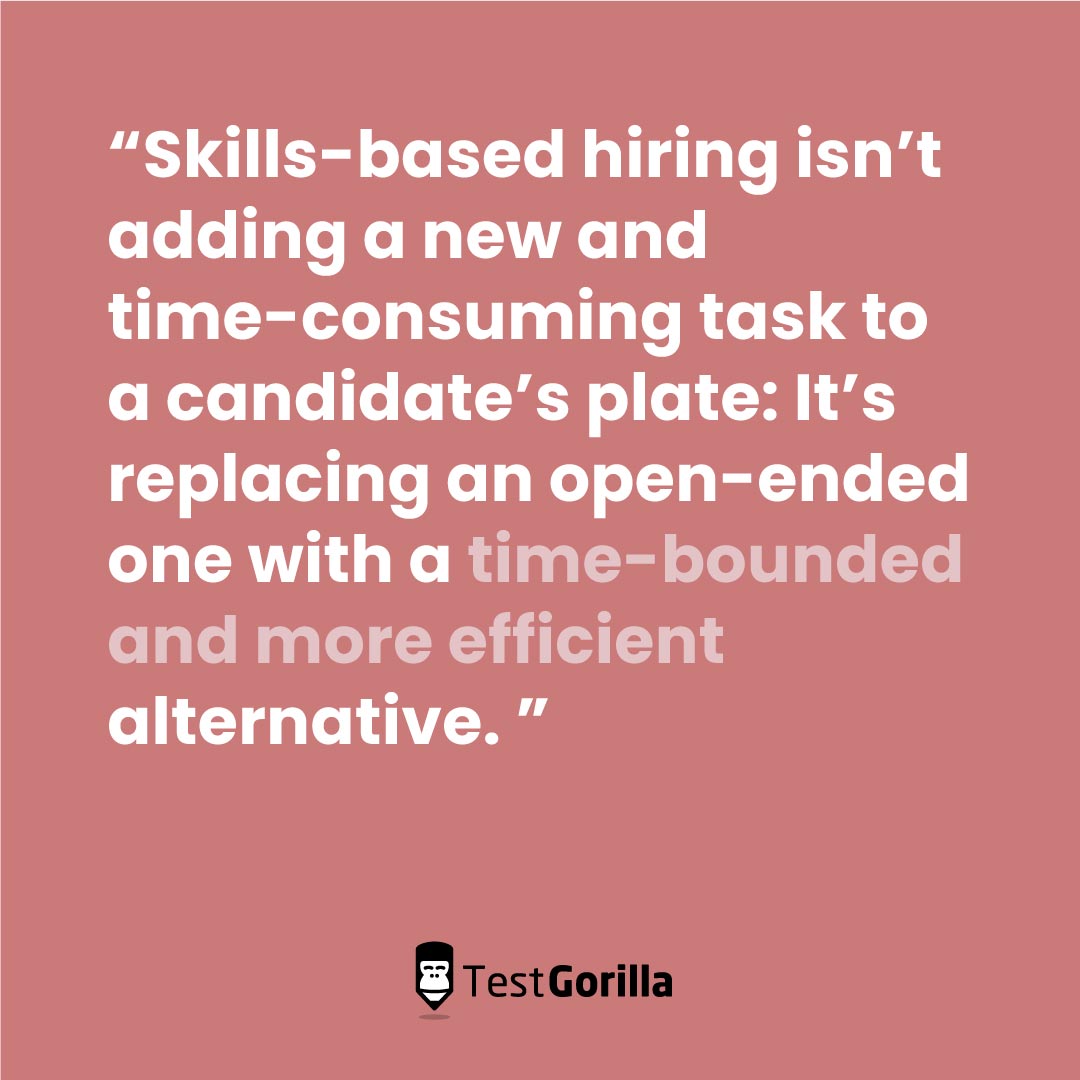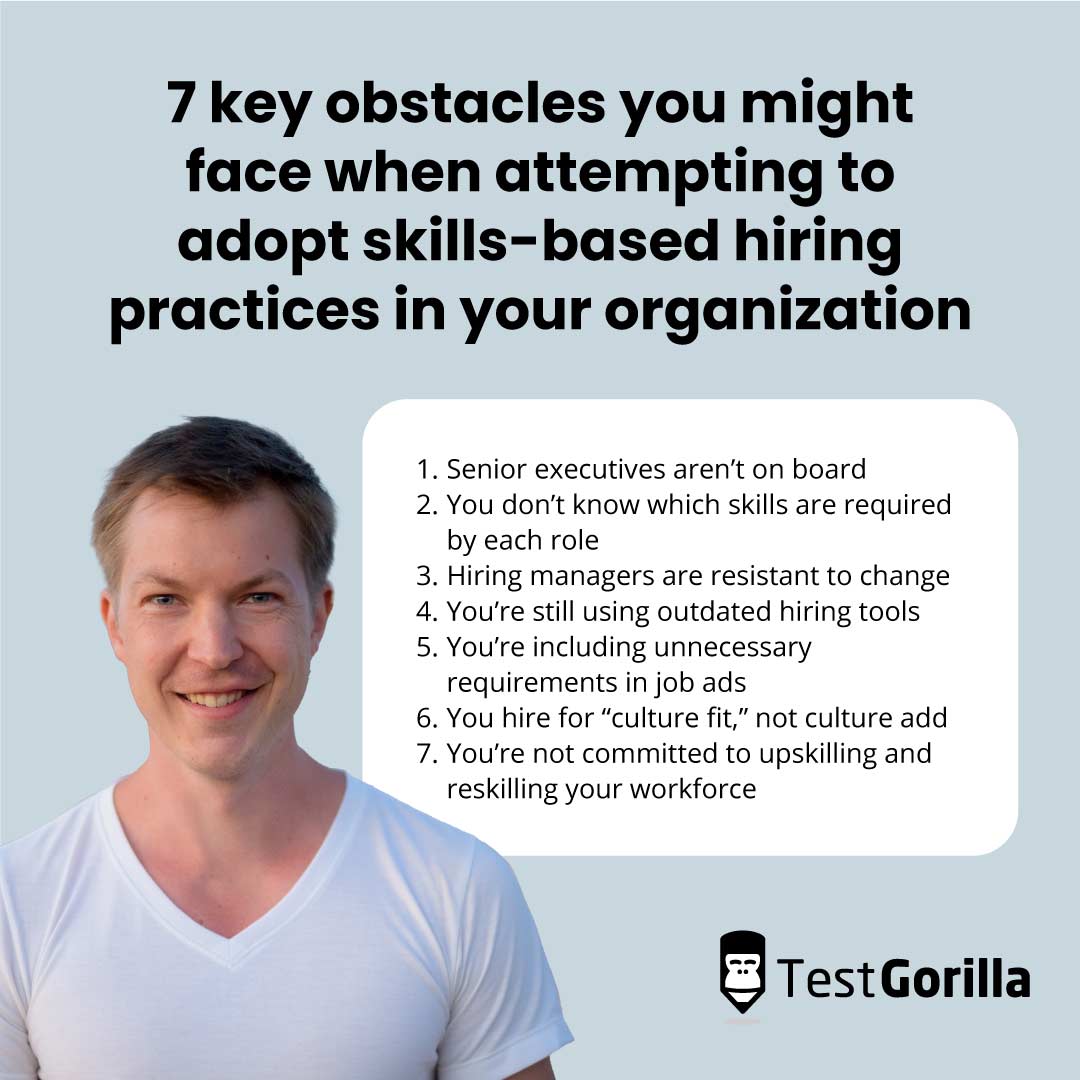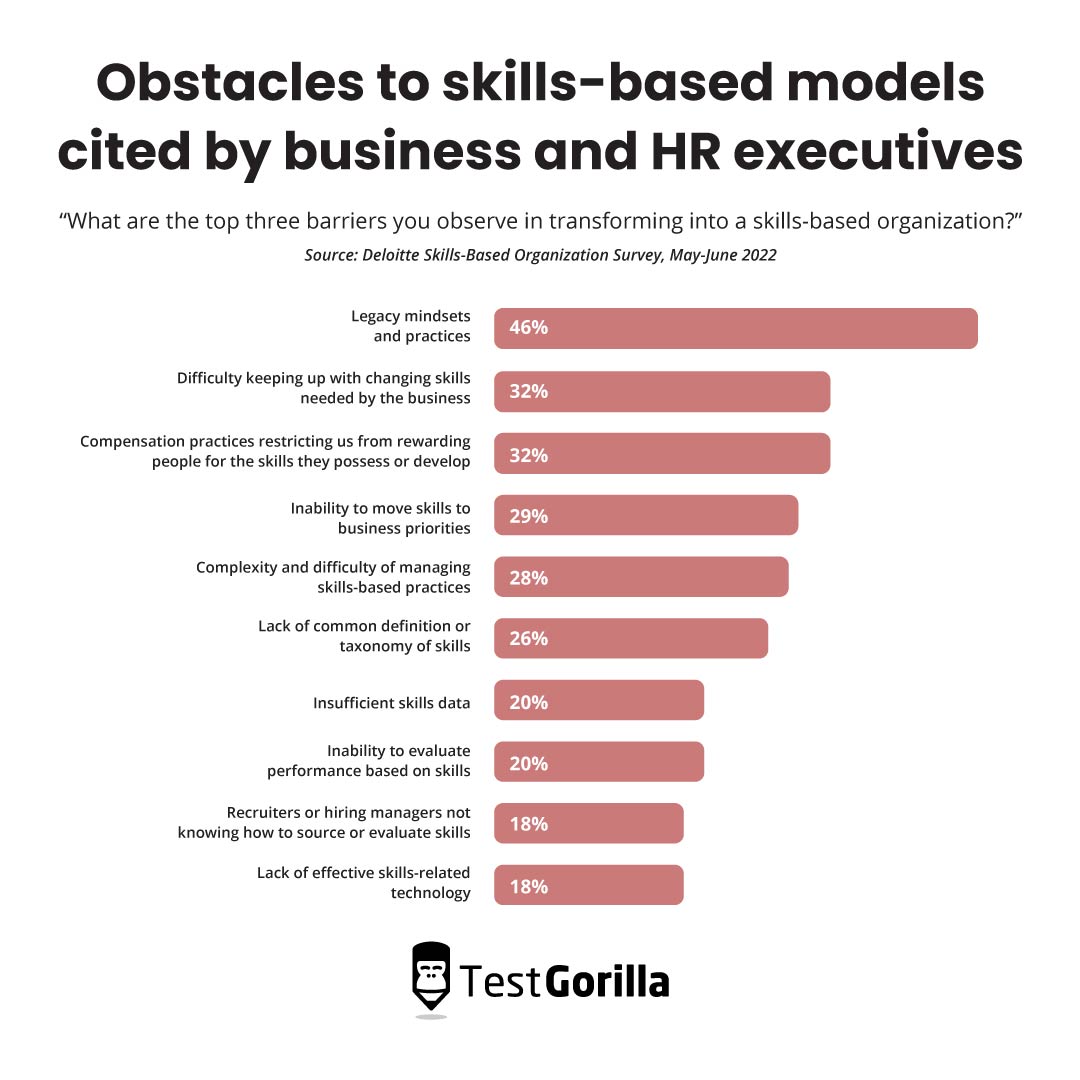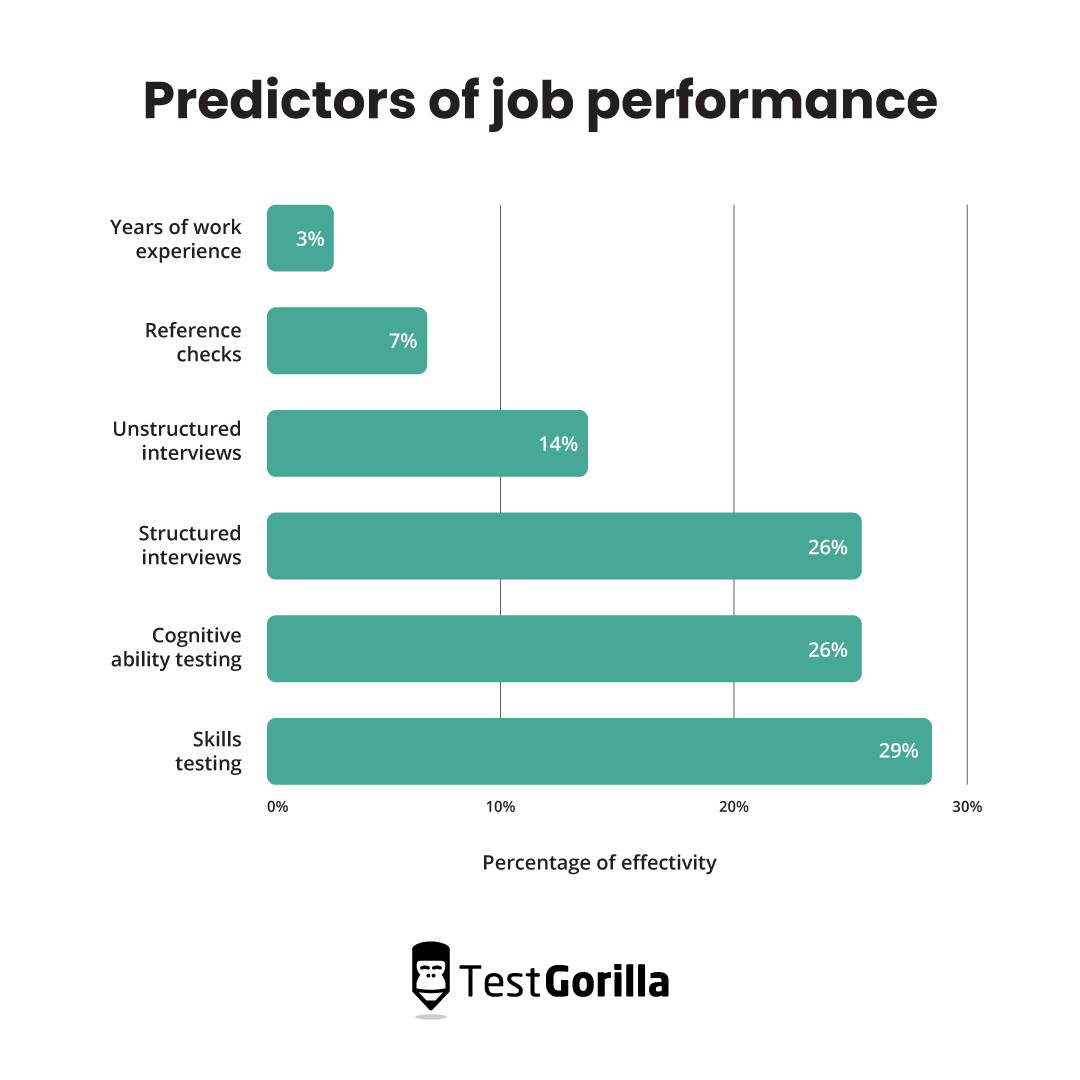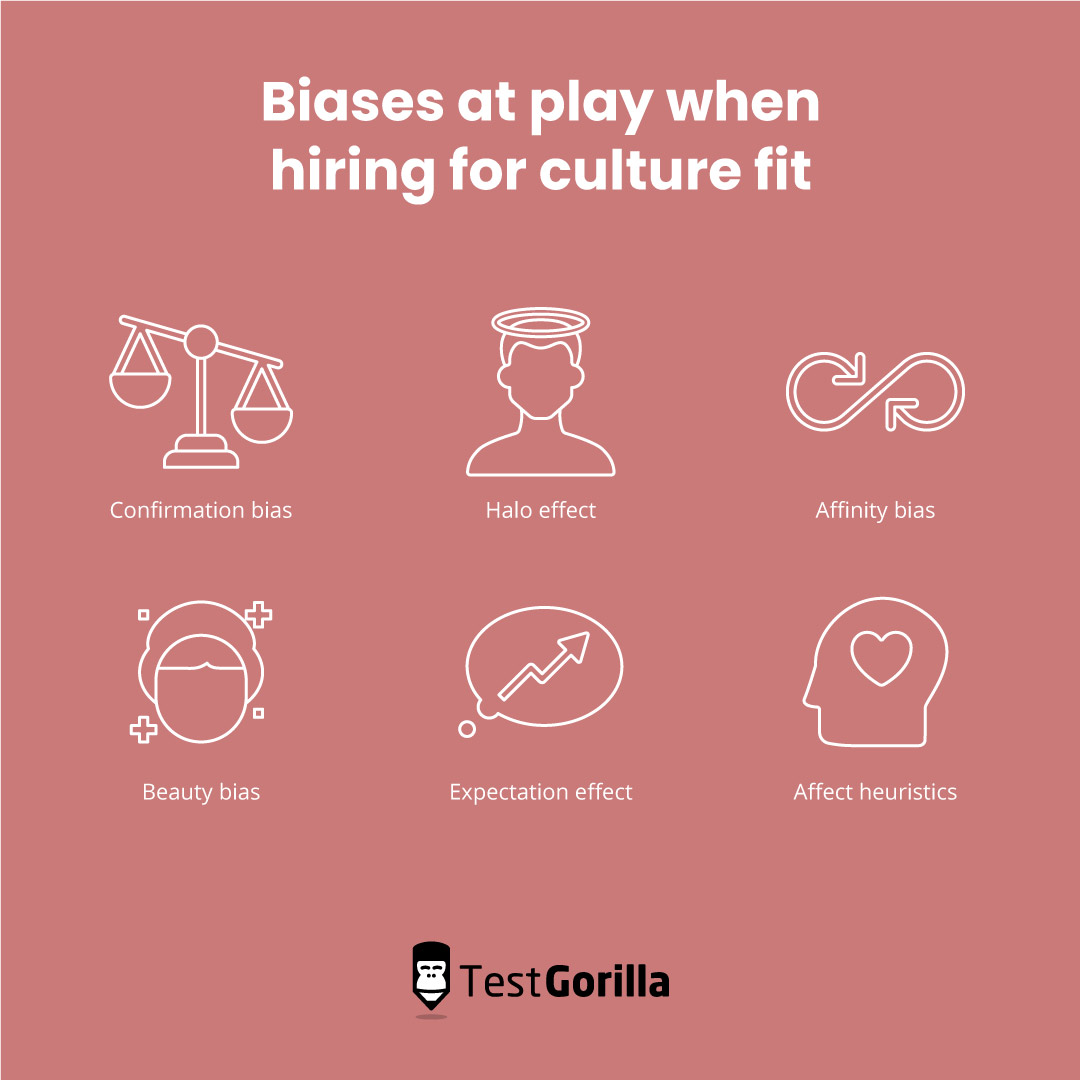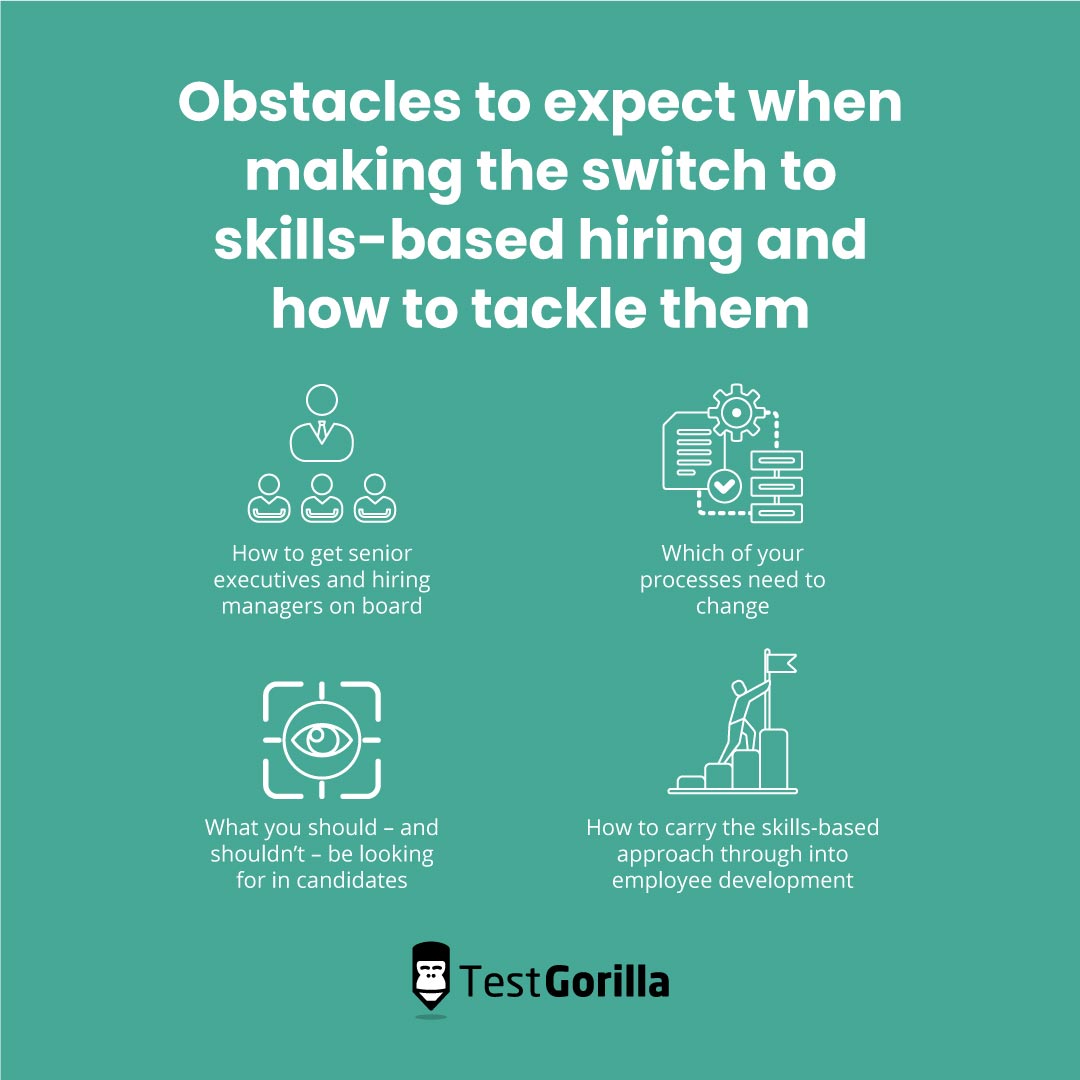7 challenges employers face when adopting skills-based hiring (and how to overcome them)
A switch to skills-based hiring brings major incentives. Our own research shows that not only is it the norm, with almost 81% of businesses already using it, but of those businesses:
78% saw a reduction in cost-to-hire
81% saw a reduction in time-to-hire
90% saw an increase in diversity
However, like any transformation, it can’t happen overnight.
To get these big results, you first have to make big changes. You can’t simply swap resumes for personality tests and find motivated candidates right away.
In this post, we discuss the barriers that are standing between you and skills-based hiring. These include the roadblocks to prepare for, the systems you need to put in place, and the proper approach to get buy-in from senior executives.
First, we need to talk about where resistance to skills-based hiring comes from.
The fears about skills-based hiring, explained
It’s no secret that we think skills-based hiring is the method of the future. It’s faster, more efficient, and more successful than traditional hiring, and it helps organizations select candidates with long-term growth potential.
If it can do all this, why do so many myths about skills-based hiring exist?
You’ve probably heard some of them already. One of the most prevalent myths about skills-based hiring is that it’s a worse experience for candidates, while another is that it unfairly penalizes college graduates with its call to scrap four-year degree requirements for most roles.
There are two main reasons why myths like these perpetuate:
Skills-based hiring is new
It’s misunderstood
Skills-based hiring is a radical departure from our current norms. In a purely skills-based approach, you would scrap resumes, implement pre-interview testing, and switch to a structured interview approach when assessing candidates (more on this later).
Naturally, when asked to throw out the familiar, we become critical of the proposed replacement. Leaders are eager to notice that skills-based hiring might require signing up for a testing service (a new cost) but hesitate to turn that same scrutiny on their current hiring practices and the costs hidden in their slow time-to-hire.
Its newness also makes it easier to misunderstand. Consider the myth that skills-based hiring offers a worse candidate experience. The logic here claims that asking candidates to take a two-hour pre-interview assessment at the start of the hiring process – in place of the familiar resume and cover letter – is off-putting or even disrespectful.
However, in our experience, skills-based hiring offers a better experience from a candidate’s perspective and actually saves them time.
With skills-based hiring, candidates no longer need to spend an unknown number of hours editing their resume and crafting a cover letter that may not fully convey their fit for the role or even be read by the recruiter. Instead, they only need to commit to a single, time-bounded activity that addresses the key skill areas of the role and is guaranteed to be considered.
Skills-based hiring isn’t adding a new and time-consuming task to a candidate’s plate: It’s replacing an open-ended one with a time-bounded and more efficient alternative.
As for the myth about skills-based hiring penalizing graduates, we’ll dig into that later.
Now that we’ve identified the root of leaders’ resistance to skills-based hiring, it’s time to examine how that resistance will manifest itself as you make the switch – and what you can do to clear each obstacle.
What’s stopping you from implementing skills-based hiring today? 7 challenges
As we see it, there are seven key obstacles you might face when attempting to adopt skills-based hiring practices in your organization.
Some of them spring directly from the common myths about skills-based hiring we referenced above and can be debunked with hard data. Others come from the existing systems and processes at work in your business, which you simply need to adjust.
Here’s how to tackle them.
1. Senior executives aren’t on board
More and more companies are doing away with traditional hiring staples such as degree requirements in favor of skills-based hiring methods, but there’s still significant room for improvement.
Take the degree requirements for Software QA Engineer postings across big tech firms, for example. Just over a quarter of Accenture’s Software QA Engineer job postings state the requirement for a degree, and only 29% at IBM. Meanwhile, 100% of these postings at Oracle do, as do 94% at Intel, 92% at HP, and 90% at Apple.[1]
That’s a huge gap. Clearly, when a firm discovers skills-based hiring, they go all-in. But how can you convince your leaders to take the leap?
Making the case for skills-based hiring
Firstly, you should communicate to your leaders that when it comes to values and fighting discrimination, skills-based hiring is one of the best ways to put your money where your mouth is.
Lily Zheng, a diversity, equity, and inclusion researcher, observes that Corporate Social Responsibility, which refers to voluntary, self-regulated initiatives by companies that often don’t create any tangible change, is being superseded by Corporate Social Justice.
Corporate Social Justice, by Zheng’s description, is a framework for making positive change that is measurable and accountable to the community of employees, shareholders, and customers that benefit from it.
The changes that skills-based hiring requires, along with the benefits that a focus on skills can have for your employees once they’re hired, tangibly reduce discrimination in your hiring and internal processes. It’s a great start to any Corporate Social Justice movement.
That’s the big-picture argument.
Next, it helps to dive into specifics, demonstrating both the large-scale impact of skills-based hiring for your organization and the specific ways in which it is relevant to your mission.
To tackle the first point, make it clear to your employer that eliminating bias isn’t just a good deed; it’s a necessity. Pipeline research found that for every 10% increase in intersectional gender equity, organizations achieve a 1-2% boost in revenue.[2]
As for how it can specifically help your business, that brings us to our next point.
2. You don’t know which skills are required for each role
It takes more than simply breaking down your leaders’ misconceptions and presenting them with data about the usefulness of skills-based hiring to execute a strong strategy.
You also need to show them how it can work for your organization specifically by identifying the critical skills required for each of your open roles.
Deloitte research shows that many senior leaders’ misgivings about skills-based hiring models are based on a lack of understanding of the role that different skills play in their business, both in the present and as the company evolves over time.
It’s no wonder that the US Chamber of Commerce Foundation recommends that employers identify the critical skill requirements for their roles as the first step to transforming hiring.
So, where do you start?
Identifying skills requirements and skills gaps
You probably already know the basic skills required for each role – for instance, you know that your web developers need to be fluent in whatever programming language your system uses. But do you know which other skills support these functional ones to contribute to employee success? Probably not, right?
The easiest way to assess employees’ skills is to administer skills tests to your employees. We recommend combining up to five skills tests per assessment and tailoring each assessment to the employee’s role.
This way, the assessment can give you an objective overview of each employee’s skills and identify the key skill sets for each role and function. For example, you might find that in addition to Python proficiency, your lead developer is also a highly-skilled communicator and project manager and look to replicate these skills in a new recruit.
This method can also help you identify skills gaps. For example, you may discover that your development team is a tad short on project management skills. This insight can help focus your hiring efforts beyond just the basic requirements of the role and look at how the new employee could supply these missing skills.
You might also want to combine these assessments with other methods, including self-assessment and 360° feedback: when employees are reviewed by their peers and direct reports as well as their managers.
The end goal is to both identify the core hard skills required of each role (such as programming proficiency) and to:
Identify the soft skills required in each team
Define each of these core skills so that all leaders and hiring managers are on the same page about what they mean
Collect data on the overall range of skills at your company and identify skills gaps
Craft an efficient process and benchmarks for skill evaluation that you can use on an ongoing basis
3. Hiring managers are resistant to change
Boosted efficiency, reduced cost-to-hire, and reduced bias are certainly all attractive benefits to business leaders.
However, you might be surprised to find that despite all these, many hiring managers still resist implementing skills-based hiring methods. This is because the focus on skills-based hiring’s ability to eliminate bias may make HR professionals feel that they are being accused of overt racism, sexism, or other prejudice in their hiring decisions.
It’s not just recruiters that can be put off by the switch to a skills focus, either. Other employees might feel that the suggestion of bias in the hiring process invalidates their appointment. Studies show that being presented with the “business case for diversity” actually prevents marginalized candidates from applying for a role.
But there’s a way to reduce this backlash – communicate to employees that skills-based hiring is there to support them, not to fix them. [3]
Getting buy-in for pre-employment testing
Don’t frame pre-employment testing as a way to stop hiring managers from making biased decisions. Instead, say that pre-employment testing saves recruiters time and supports them in decision-making by providing clear data across all candidates.
This view of skills-based hiring places less blame on your employees, which makes them more amenable to change.
4. You’re still using outdated hiring tools
One of the core tenets of skills-based hiring is that businesses should jettison old hiring tools like resumes and unstructured interviews to make way for more efficient, objective ones like pre-interview assessments.
This sounds like a radical approach, but Google found that skills testing was over twice as effective as unstructured interviews in predicting job performance, followed closely by structured interviews.[4]
A shift to newer tools sounds simple enough, but you may not even realize how wedded your hiring managers are to standard protocols like resumes until you ask them to give them up.
43% of employers say they struggle to determine an applicant’s skills from their resume, and 51% say they struggle to determine whether the resumes of their applicants are accurate. Despite this, 82% of employers have used resumes to hire in the past 12 months.
Ditch resumes for skills testing
Again, the key is to highlight how skills-based hiring can take tedious tasks off their plate and free them up to do the work they love: finding the perfect candidate for an open role.
Let’s start with resumes. Say you receive 200 applications for an open role. Even if you only spent one minute skimming each CV (never mind the cover letter), that’s over three hours of reading what candidates say they can do. You’ve not even evaluated whether they can actually do it yet!
By contrast, using a pre-interview assessment to screen candidates can help you automatically filter out weaker applicants to create a shortlist for you to interview.
Once they’re in the interview, ditch the unstructured interview approach for a structured one. With the structured approach, you decide the questions in advance and set benchmarks for performance in each answer. This makes the hiring decision faster and gives you more confidence in your decision.
5. You’re including unnecessary requirements in job ads
Even if your hiring managers are on board and using the best skills-based techniques, you’ll still see diminished returns if you include unnecessary job requirements in job ads.
The most common of these requirements are:
A four-year college degree when the role doesn’t require one
An arbitrary number of years of experience
Again, a lifetime of familiarity with traditional hiring practices might be telling you to pump the brakes here. “Get rid of the ‘years of experience’ requirement?” your inner voice is roaring. “We might as well start hiring kindergarteners!”
But that’s not true. Numerous studies have failed to find a link between years of experience and job success, and it’s a similar story with degrees.
When you think about it, it isn’t hard to understand why.
When you’re asking a candidate if they have a degree, you’re really looking for an opportunity to make an assumption. You might also call it a bet: You’re betting that someone having attended a university means that they have certain basic skills you’re looking for, like Excel proficiency.
But a degree in and of itself does not prove that these skills are really there. In fact, one study by the UK government found that basic IT skills and data processing with programs like Excel were among the top 10 skills businesses said graduates were lacking.
Combatting degree inflation
This requirement for college degrees in professions that previously did not ask for them is a phenomenon known as degree inflation, which has skyrocketed over the last decade. In fact, adults between ages 25 and 34 in 2022 were much more likely to be employed than the same age group in 2010, but only if they had a bachelor’s degree or higher.
Degree requirements contribute significantly to inequality, not only within your company, but within the wider economy. This is due to the vast differences in educational outcomes between racial groups in the United States, and this negative effect has only worsened during the pandemic.
Yet even if these arbitrary requirements – a degree or five years of experience – could guarantee that candidates have the skills you’re assuming they do, they don’t give you the ability to compare those skills in the way a skills test does.
Not only do these requirements exclude many skilled candidates for no good reason, but they also give your team more work to do in verifying candidates’ skills and figuring out a way to compare them.
6. You hire for “culture fit,” not culture add
Skills-based hiring is a radical change that requires support from leadership, partly because it asks you to change not only how you look for candidates but also what you look for in them.
Part of this involves moving away from the traditional concept of culture fit toward hiring for “culture add.”
It’s a subtle but important difference.
Culture fit is usually determined by individual interviewers in the final stage of the interview process. It might come down to their own mood on the day, whether the candidate makes them laugh in the interview, or asking open, often vague questions like “would you describe yourself as a leader or a follower?”
In the past, this was the best option we had when it came to building our company cultures. But when we really look at it, a vague sense of “culture fit” doesn’t tell you anything about:
The deeper values held by a candidate
Whether these align with those of your company
How these values compare to those of your current workforce
By contrast, looking for culture add can give us more insight into all of these things.
How to hire for culture add
Testing candidates for culture add potential shows you how the candidate’s values align with your company’s, without the distraction of surface traits like whether or not they and your interviewer share the same sense of humor.
This is not about ensuring that everyone in your company is organized around a single set of ideals that they adhere to equally at all times. Rather, some researchers have theorized that companies should provide a diverse “toolkit” of values that employees all mutually agree are important and from which they can draw when faced with a challenge.
At TestGorilla, two of our primary values are “Taking ownership” and “Supporting each other.” Our employees might use one or the other of these values to pursue different goals or some mix of the two.
Indeed, one study found that employees who adhered to a diverse set of ideals at their company were better equipped to innovate than those with a narrower set of cultural ideas.
7. You’re not committed to upskilling and reskilling your workforce
Finally, skills-based hiring is about maximizing the potential of every hire. You want to increase your retention and keep their valuable skills in-house, and to do that, you need to invest in them long-term by giving them upskilling and reskilling opportunities.
Studies have shown that supporting employees to expand or modify their skill sets can improve your business’s agility and ability to respond quickly to challenges.[5] It also makes you a more attractive employer: 65% of workers believe employer-provided upskilling is very important when evaluating a potential new job.
How to commit
We recommend committing to upskilling your employees by helping each of them craft a personalized professional development plan, complete with key skills they want to learn and milestones to hit.
To help them achieve these goals, consider assigning a personal development budget for them to use for skills training. At TestGorilla, we give each employee a development budget of 3.5% of their annual salary, and we’ve seen a huge benefit to our workforce.
You can also start smaller than this. You can make time for your employees to share the knowledge they already have with colleagues who don’t, for instance, by identifying digital skills disseminators to lead training on key digital concepts.[6]
Although upskilling and reskilling initiatives focus on existing employees, you can also commit to them in your hiring by looking for learnability in your candidates.
By looking for evidence that candidates can pick up skills and feedback quickly, you can make sure you hire adaptable employees who can help your organization weather change. After all, nearly 60% of the workforce already needs new skills to do their jobs effectively, and that percentage will only increase as time goes by.
The best insights on HR and recruitment, delivered to your inbox.
Biweekly updates. No spam. Unsubscribe any time.
What does the switch to skills-based hiring look like in practice?
To get an idea of how real companies have managed this switch and broken down the barriers to skills-based hiring, here are three examples from our own experience.
Fewer mis-hires
One of the key benefits you see from adopting skills-based hiring methods is a reduction in the number of employees who don’t make it past their probation period.
Let’s look at IDP Education. After two mis-hires in just a few months, they turned to pre-interview assessments to help them verify that candidates actually had the skills they said they had in their resumes.
With skills testing in place, their hires are making it past their probation period every time, saving them months they would have otherwise spent training the wrong person.
88% of employers using skills-based hiring reduced mis-hires
Decreased time-to-hire – even for complex roles
INMATEC GasTechnology FZC is a market-leading producer of on-site nitrogen and oxygen generators. If that sounds complicated, that’s because it is.
Because of the complexity of the roles they were hiring for, INMATEC had a resource-intensive hiring process that included manual testing, which took a long time and still resulted in occasional mis-hires.
Once they started using TestGorilla, the team at INMATEC was able to make faster, more precise hiring decisions (even for highly complex roles) and free up time to spend on employee engagement.
82% of employers using skills-based hiring reduced their total time-to-hire
Better prediction of job performance
Software and hardware safety solutions company 7Systems found it hard to predict job performance using traditional hiring. Like INMATEC, the roles they were advertising were highly complex, requiring a highly-specialized skill set.
94% of employers believe that skills-based hiring is more predictive of on-the-job success than resumes.
With TestGorilla, 7Systems has been able to directly test candidates’ skill levels and compare the results, which has enabled them to predict job performance with greater accuracy. Since making the switch, they’ve noticed that candidates that perform well in tests perform well in the roles once hired.
Start the switch to skills-based hiring by talent mapping your workforce
There you have it: Your roadmap to skills-based hiring. You now know what obstacles to expect when making the switch and also how to tackle them, including:
How to get senior executives and hiring managers on board
Which of your processes need to change
What you should – and shouldn’t – be looking for in candidates
How to carry the skills-based approach through into employee development
Now, it’s time to put your plan into action.
First, you need to create a talent map of your workforce using skills assessments to accurately gauge your employees’ skills and any gaps in your resources.
Use our comprehensive guide to talent mapping to get your strategy off the ground, and head to our test library for the tools. We have tests for everything from mechanical reasoning to communication skills.
With a strong understanding of the skills available in your workforce and a strategy in place to expand them, you’ll future-proof your business against skills gaps and supercharge innovation. Good luck!
Sources
“The Emerging Degree Reset”. (February 9, 2021). The Burning Glass Institute. Retrieved February 13, 2023. https://static1.squarespace.com/static/6197797102be715f55c0e0a1/t/6202bda7f1ceee7b0e9b7e2f/1644346798760/The+Emerging+Degree+Reset+%2822.02%29Final.pdf
“Accenture Makes Strategic Investment in Pipeline to Accelerate Gender Parity in the Workplace”. (August 6, 2021). Accenture. Retrieved January 12, 2023. https://newsroom.accenture.com/news/accenture-makes-strategic-investment-in-pipeline-to-accelerate-gender-parity-in-the-workplace.htm
Zheng, Lily. “To Avoid DEI Backlash, Focus on Changing Systems — Not People”. (September 21, 2022). Harvard Business Review. Retrieved February 6, 2023. https://hbr.org/2022/09/to-avoid-dei-backlash-focus-on-changing-systems-not-people
Bock, Laszlo. (April 2015). “Here’s Google’s Secret to Hiring the Best People”. WIRED. Retrieved January 5, 2023. https://www.wired.com/2015/04/hire-like-google/
Wilde, Sari; Smith, Alison; Clark, Sarah. “Organizations Need a Dynamic Approach to Teaching People New Skills”. (November 26, 2021). Harvard Business Review. Retrieved February 2, 2023. https://hbr.org/2021/11/organizations-need-a-dynamic-approach-to-teaching-people-new-skills
Kropp, Brian; Smith, Alison; Cain, Matt. “How to Build Digital Dexterity Into Your Workforce”. (October 04, 2021). Harvard Business Review. Retrieved February 06, 2023. https://hbr.org/2021/10/how-to-build-digital-dexterity-into-your-workforce
Related posts
You've scrolled this far
Why not try TestGorilla for free, and see what happens when you put skills first.


